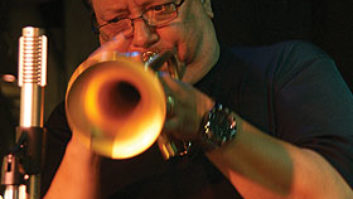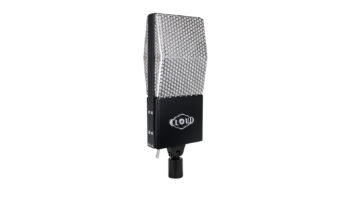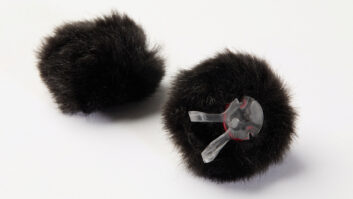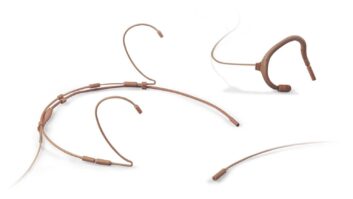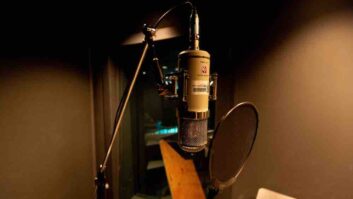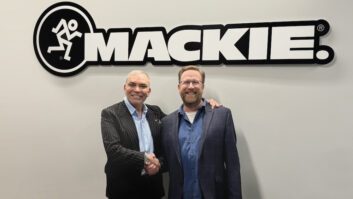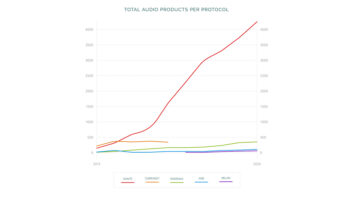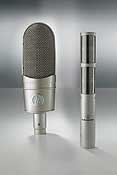
It’s been nearly 80 years since RCA engineer Harry Olson filed his patent (#1,885,001) for the first ribbon (velocity) microphone, and the audio world hasn’t been the same since. Long a mainstay of instrumental and vocal recordings, the popularity of ribbon microphones is at an all-time high. The number of users who appreciate the flexibility of these figure-8-patterned mics continues to grow, and in the past 18 months more than two dozen new ribbon mics have come on the market, resulting in more models, more options—such as onboard active electronics or mics ruggedized for live sound applications—and a greater selection at nearly every price range. With a lot of activity in the market, we checked out what’s new.
Audio-Technica AT4080 and AT4081
Unveiled at last year’s AES show and now shipping are the AT4080 and AT4081, the first ribbon mics from Audio-Technica. These hand-built, active ribbon designs feature onboard phantom-powered electronics that bring their output to near-condenser levels, allowing for use with any pro preamp. Both the larger AT4080 ($1,245 with shockmount and carrying case) and the low-profile AT4081 ($895 with isolation clamp mount and windscreen) feature powerful neodymium magnets and innovative dual-ribbon construction for smooth bidirectional response with high SPL handling. The company’s MicroLinear ribbon design minimizes lateral flexing for durability and freedom from ribbon distortion. (See Russ Long’s review.)
qqq

Apex 215
The Apex215 combines two low-mass aluminum ribbon elements to provide greater output sensitivity. List price is $249, including shockmount. Also with a $249 list is the Apex 210, a single-element design with a 2-micron ribbon that handles 165dB SPLs. It has an integrated yoke mount with internal shockmounting and ships with an aluminum carry case.

ART M-Five
ART’s M-Five has a 35mm low-mass/low-tension, 2.5-micron corrugated aluminum ribbon handling 148dB SPLs and a dent-resistant, stainless-steel mesh windscreen atop its black aluminum body. The M-Five retails at $199 and includes a shockmount and aluminum carry case.

AEA R88mk2
Wes Dooley of Audio Engineering Associates almost single-handedly began the modern ribbon mic movement with his reissues of classic RCA ribbon mics, starting with the R44 in 1998. Now, AEA has expanded its extensive offerings with two new models. Optimized for recording instruments and ensembles in stereo, AEA’s R88 ribbon mic has been redesigned as the R88 mk2, with improved shockmount and cable connections. Its two undamped, long ribbon elements are angled at 90 degrees to each other in the Blumlein stereo configuration, and the mic is finished in stealth black for unobtrusive use in live applications. Retail is $1,895, including a high-quality soft-sided case, cotton mic bag, 4-meter stereo XLR breakout cable and variable-angle stand adapter. AEA is also now shipping the R84 Silver Limited Edition (SLE) of its R84 with chrome-end caps in a run of only 125 units. The R84 SLE’s output is 3 dB higher than the RCA 44, and its 11.5-inch-tall silhouette is reminiscent of the RCA 77. The R84 SLE is $1,225 (or $2,550 in match pairs) with hard-wired 3-meter output cable, stand adapter and upright hard case.

Cascade Knucklehead
Previewed at Summer NAMM 2010, the Knucklehead ($225 list) from Cascade Microphones takes the element from the company’s Fat Head mic and incorporates it into a brass-and-aluminum body with an integrated swiveling shockmount. The mic is offered in a 2.5-micron version and live application–ready 5-micron model. Both can be ordered with a Lundahl transformer as a $125 option. Also intended for SR applications—and used on recent tours by Steely Dan and Pat Metheny—is the Fat Head II Live, which has a 5-micron aluminum short ribbon and ships with an aluminum carry case, wood storage box and shockmount. In addition to the $225 standard Fat Head II Live, it’s also available with either Lundahl or CineMag transformers for $335. The C77 features a 2.5-micron, short ribbon element routed to a Lundahl LL2913 output transformer with Evidence Audio internal solid-core copper wiring and Switchcraft XLR jack. It’s assembled in Olympia, Wash., and retails at $499, including swiveling yoke mount, padded case and upright aluminum storage/travel case.

Cloud Microphones JRS-34
After 20 years of servicing and restoring vintage ribbon mics (skills learned from his father, ex-RCA engineer Jon R. Sank who designed the BK-11 ribbon mic), Stephen Sank of Cloud Microphones has launched a new line of mics. Handmade in Tucson, Ariz., the JRS-34 features a hand-cut, corrugated aluminum ribbon in a radiused, rounded neodymium magnet structure that reduces internal reflection/diffraction effects. The ribbon output feeds an onboard, phantom-powered JFET preamp to add 20 dB to the signal. The JRS-34 has a brushed-nickel finish with a nickel-plated screen and retails at $1,799, including a custom wooden storage box. It’s also available as the black-finished JRS-34-TV. The same ribbon element—without onboard electronics—is also used as the passive JRS-34-P ($1,499) version, which is gray with nickel screens and a silver logo. All Cloud mics are fitted with CineMag output transformers.

Coles Electroacoustics 4050
For the 4050 ($2,500), its first stereo ribbon microphone, Coles Electroacoustics took the element developed from its 4040 model and set it into two mono mics that use magnetic closures to snap them into a single unit. The system allows a full 360 degrees of rotation adjustment for a variety of stereo configurations, or the two can be used separately for spaced-pair placements. As each mic uses a standard XLR-3 connector, no stereo adapters or specialized breakout cabling is necessary. Price includes a custom shockmount and carry case.

MXL Microphones R-77
MXL Microphones has two new ribbon models. Designed to emulate classic RCA ribbon mics and priced at $599 (or $749 as the R-77L with Lundahl transformer), the R-77 has a chrome body and gold-mesh windscreen with a 1.8-micron aluminum ribbon element. It ships with an integrated swivel yoke mount, wooden storage box, desktop stand and 25-foot Mogami XLR mic cable. The R144 sports a distinctive purple body with chrome grille, a 1.8-micron ribbon and internal Mogami wiring. Retail is $159, including shockmount and carry case.

Royer Labs R-101
A dozen years after leading the modern ribbon microphone revival with its popular R-121, Royer Labs continues developing innovative new products. Debuting this month is the R-101, featuring a 2.5-micron aluminum ribbon motor based on the R-121 model, but in a 1.5-inch diameter cylindrical body with no protruding pole pieces. Retail is $895, including shockmount and carry case. Another recent entry, Royer’s SF-24V ($6,195) is a stereo mic with twin head amplifiers using mil-spec 5,840W pentode tubes (wired in triode configuration) and custom Jensen output transformers delivering a high -38dB output to dual XLRs on the external power supply. The SF-24V is two matched 1.8-micron ribbon mics placed one above the other in the classic Blumlein coincident pair configuration.

SE Electronics RNR1
SE Electronics’ RNR1 is an East-West collaboration, with Rupert Neve handling the electronics of this active ribbon mic and SE’s Siwei Zou handling the transducer design and manufacturing side. The result is a ribbon mic with an extended response that’s stated to be an unprecedented 20 Hz to 25k Hz, due in part to the design that features dual custom-designed input and output transformers (before and after the active single-ended discrete electronics section) and the 2.5-micron element itself, which is set into a elongated slanted body that reduces diffraction interference. Retail is $1,995 with shockmount and case. Also new from SE are the Voodoo VR1 and Voodoo VR2 models, which feature a stated 20kHz bandwidth based on a new Zou-designed ribbon element. The latter extends response by creating a resonant cavity formed by thin, perforated high-frequency–compensation plates on either side of the magnetic structure, with the effect of reducing the time differences between sounds arriving on the front and rear sides of the 2-micron ribbon. The $799 VR1 is a passive version; housed in a slightly longer body, the VR2 ($1,199) uses the same ribbon element but is an active model with phantom-powered electronics that boost the mic’s output by 16 dB.

Shure KSM353
Shure created classic ribbon mics from the 1950s through ’80s, and high-performance ribbons are back in the company’s catalog in the form of the Crowley and Tripp–rebranded El Diablo and Naked Eye ribbon mics, now offered as the KSM353 and the KSM313. Both feature tough Roswellite ribbons, which are said to provide improved shape memory over conventional materials. The KSM313 ($1,619, with wood storage case and swivel mount) has a “Dual Voice” design. The front side of the mic has a brighter character while the rear side is darker, so users can choose from two variations when recording different sources. Retailing at $3,369 (with shockmount and wood storage box) and suited for solo use or paired for M/S or Blumlein stereo miking, the KSM353 has matched front/rear performance from 30 to 15k Hz at up to 146 dB.

Sontronics Delta
Following its Sigma ribbon mic, Sontronics’Delta is designed for high SPL handling, with a mid-emphasis response tailored to keep guitar cabs and horns upfront in the mix, either onstage or in the studio. Its active, phantom-powered electronics offer high output and low-noise (14dBA) performance, while its effective shockmount removes stage rumble and vibration. Retail is $899 with aluminum flight case.
Mix
executive editor George Petersen is an avowed ribbon mic fanatic.
